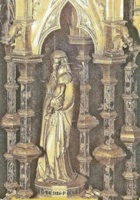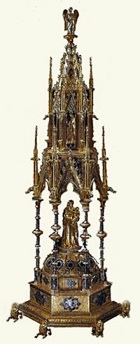


Detail - Reliquary of St Sabinus
(see below)
An entry in the Roman Martyrology under 9th February reads: “At Canossa in Apulia, St. Sabinus, bishop and confessor. Blessed Pope Gregory tells that he was endowed with the spirit of prophecy and the power of miracles. After he had become blind, when a cup of poison was offered to him by a servant who was bribed, he knew it by divine instinct. He, however, declared that God would punish the one who had bribed the servant, and, making the sign of the cross, he drank the poison without anxiety and without harmful effect”.
In fact, the Dialogues of Pope Gregory I (Book III, Chapter 5) also contains a second anecdote relating to “Sabinus, Bishop of Camisina”. Totila, King of the Goths, who was sceptical about the prophetic powers of the blind St Sabinus, visited and had dinner with him. He handed him a glass of wine, in place of the cupbearer. “Then the man of God taking the cup, but not seeing him that did deliver it, said: ‘Blessed be that hand’. At which words the King very merrily blushed, because, albeit he was taken, yet he had found that gift in the man of God which before he desired to know”.
Bishop Angelarius rescued the relics of St Sabinus and took them to Bari when Canosa was destroyed by Saracens in in 844. It is not clear some of them came to be venerated in San Giovenale, Orvieto. The Cappella di San Sabino, to the left of the apse of this church, was built at the end of the 13th century on what might have been the site of a free-standing Oratorio di San Sabino. This church itself is referred to as SS Giovenale e Sabino in a document of 1314. A reliquary (1340) by Ugolino di Vieri for the skull of St Sabinus of Canosa (see below) was displayed in this chapel until 1845, when it was sold to the Museo dell’ Opera del Duomo. The rest of the saints’ relics are said to rest under its tufa altar.
A document of 1571 records that Carvajal dei Carvajal-Simoncelli built and endowed a “church or oratory” in his palace, Palazzo Carvajal, near San Giovenale. Pericle Perali (referenced below, at p 135) identified this as the Oratorio di San Sabino. He also added:
-
✴that it housed a “decorosissima tavola” (very decorous panel) dated 1473, which was attributed to Giovanni Boccati (see below); and
-
✴that a high tower near the palace that was known as the Torre di San Sabino had collapsed in 1616 (in the reference below, at p 27).
Reliquary of St Sabinus (ca. 1340)

The cranium of the saint is housed under the cupola above the hexagonal base of the reliquary. Three golden figures adorn the higher registers::
-
✴the Madonna and Child stand above the cupola;
-
✴St Sabinus stands in the register above it; and
-
✴an angel at the top, which was added in the second half of the 19th century to replace an earlier figure.
The six enamels in the base depict scenes from the life of St Sabinus.
St Sabinus Altarpiece (1473)
This altarpiece, which is dated by inscription, was documented in the Oratorio di San Savino in Palazzo Carvajal (which was then called Palazzo Pietrangeli) in 1829, and was first attributed to Giovanni Boccati in 1866. A document in the archives of Orvieto records that Antonio Simoncelli, the father of Cardinal Girolamo Simoncelli, made a payment to Giovanni Boccati in 1473, and this almost certainly relates to this altarpiece.
The altarpiece was placed on the art market in Florence in 1895.
-
✴The main panel and the original frame (minus the predella panel) were sold to the Szpmvszeti Muzeum (Museum of Fine Arts), Budapest.
-
•The panel itself depicts the Madonna and Child enthroned, with SS Juvenal, Sabinus of Canosa, Augustine and Jerome, against a gold background. There are two standing angels on each side of the Madonna, and two sit on the marble pavement at her feet, playing stringed instruments.
-
•The upper cornice of the frame contains three painted angels with garlands, and there is a figure of Christ the Redeemer in the lunette above.
-
✴The predella panels depict four scenes from the life of St Sabinus:
-
•St Sabinus talking to his friend, St Benedict on Monte Cassino about Totila's entry into Rome (now in the Museo Thyssen-Bornemisza, Madrid);
-
•St Sabinus recognises Totilla (once in the Mario Lanfranchi collection, Rome);
-
•the Archdeacon Vindemius attempts to poison St Sabinus (now in the Galleria Nazionale, Urbino); and
-
•death of St Sabinus (once in the Spiridon collection, Paris).
There is some confusion as to the original location of the altarpiece:
-
✴Some sources indicate that it came a chapel in the Duomo that was dedicated to St Sabinus of Canosa, but there is no record that any such chapel ever existed.
-
✴More recent scholars suggest that it was painted for the Oratorio di San Savino in Palazzo Carvajal. Cardinal Girolamo Simoncelli, the son of Antonio Simoncelli, built the palace in 1548, and Caravajal dei Caravajal-Simoncelli built the oratory in 1571. It is possible that an earlier palace and oratory on this site belonged to the Simoncelli family at the time that the altarpiece was commissioned.
-
✴A more likely candidate for its original location seems to me to be San Giovenale, near Palazzo Carvajal, given that:
-
•the altarpieces features St Juvenal as well as St Sabinus;
-
•San Giovenale contained relics of St Sabinus and was documented as SS Giovenale e Sabino in 1314; and
-
•St Sabinus features in a number of other works in the church; and
-
•one of the above is a second altarpiece (ca. 1490) with the Madonna and Child enthroned an SS Juvenal, Sabinus of Canosa, with three scenes from the life of St Juvenal in its predella .
-
It is possible that Antonio Simoncelli commissioned the altarpiece for the church, and that it reverted to his descendants before 1807, when Palazzo Carvajal was sold to the Pietrangeli family.
Read more:
M. Minardi, “Giovanni di Pier Matteo Boccati” in
A. De Marchi (Ed.), “Pittori a Camerino nel Quattrocento” (2002) Jesi, pp 283-8, catalogue items 27-31
A Roca de Amicis, “Palazzo Carvajal, Orvieto”, in
A. Cambareri and A Roca de Amicis, “Ippolito Scalza (1532-1617)”, (2002) Perugia, 178-9 for Palazzo Carvajal and the new Oratorio di San Sabino (1571)
V. Benucci. “L' Antica Chiesa di San Giovenale in Orvieto”, (2000) Orvieto (p6 for the document of 1314 referring to SS Giovenale e Sabino; p10 for the Cappella di San Sabino; p45 for the Reliquary of St Sabinus
P. Perali, “Orvieto: Note Storiche di Topografia e d' Arte, dalle Origini al 1800” (1891) Città di Castello (reprinted in 1979)
Return to Saints of Orvieto.

